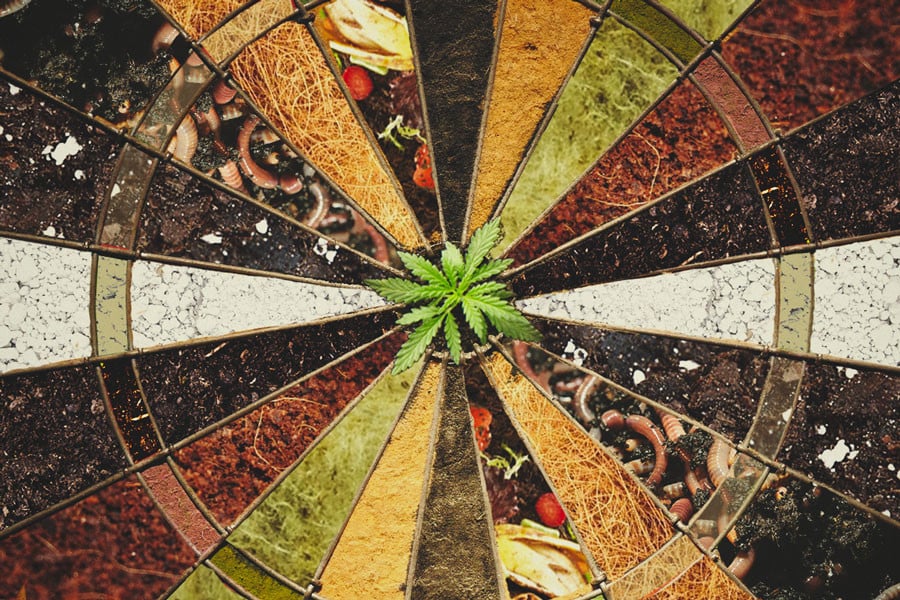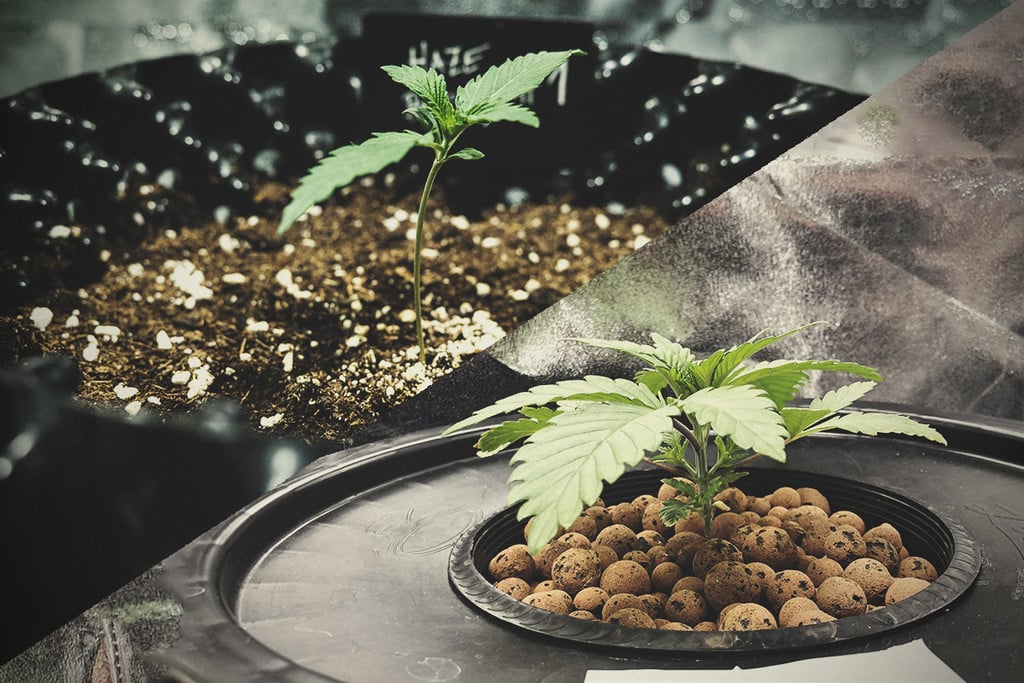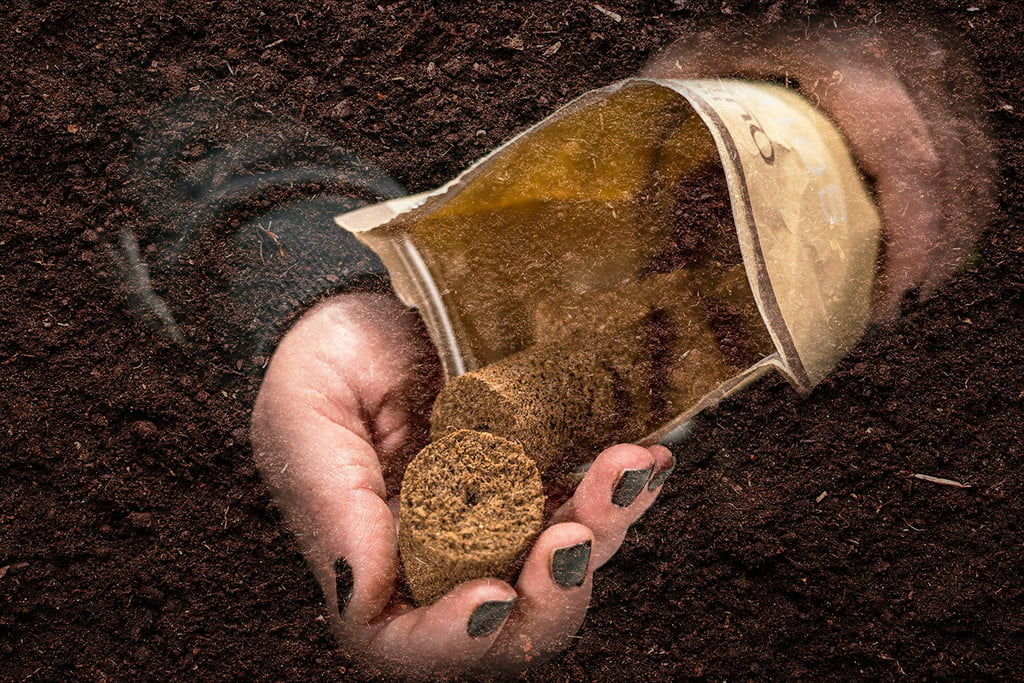 Weed Grow Guide by Royal Queen Seeds
Weed Grow Guide by Royal Queen Seeds
- Growing weed step by step
- Marijuana growing basics
- Choosing your seeds
- How to germinate seeds
- The marijuana vegetative stage
- The marijuana flowering stage
- Harvesting marijuana
- Trimming, drying, and curing
- Choosing pots and soil
-
Growing indoors
- A Complete Overview Of Growing Cannabis Indoors
- Cannabis Cultivation Tips: How To Set Up Indoor Grow Lights
- How Many Cannabis Plants Can You Grow Per Square Metre?
- Indoor Cannabis Growing: Relative Humidity and Temperatures
- Hydroponics Cannabis Growing Guide (with diagrams)
- Cannabis Micro Growing: Growing Great Weed in Tiny Spaces
- Growing outdoors
- How to grow autoflowering marijuana
- Marijuana nutrients and pH
- Marijuana troubleshooting: Nutrients
-
Marijuana troubleshooting: Growing
- Cannabis Seed Germination — Troubleshooting Guide
- How to Deal With Pythium (Root Rot) in Cannabis Plants
- Slow Cannabis Plant Growth And What You Can Do About It
- How to Deal With Leggy Cannabis Seedlings
- Watering Your Cannabis: How to Fix Overwatering and Underwatering
- Understanding Male, Female, And Hermaphrodite Cannabis
- Identifying and Treating Common Cannabis Ailments
- How To Revive a Sick Cannabis Plant
- How to Avoid Moldy Marijuana During Drying and Curing
- How to Prevent and Treat Dry and Crispy Cannabis Leaves
- What Cannabis Leaves Can Tell You
- Causes and Solutions for Yellow Cannabis Leaves
-
Marijuana Strains Grow Report
- HulkBerry Automatic Grow Report
- Blue Cheese Auto Grow Report
- Purple Punch Automatic Strain Grow Report
- Triple G Automatic Grow Report
- Do-Si-Dos Automatic Grow Report
- Green Gelato Automatic Grow Report
- Haze Berry Automatic Grow Report
- Purple Queen Automatic Grow Report
- Cookies Gelato Automatic Grow Report
- Sherbet Queen Automatic Grow Report
- Sweet Skunk Automatic Grow Report
- Medusa F1 Grow Report
- Marijuana plant training
-
Marijuana growing tips
- The Cannabis Plant Anatomy
- How to preserve seeds - RQS USA
- How Much Sunlight Do Outdoor Cannabis Plants Need To Grow?
- How to Control and Prevent Stretching in Cannabis Plants
- My Cannabis Plants Are Growing Too Tall: What Should I Do?
- Should You Worry About Purple Or Red Cannabis Stems?
- What To Do When Your Indoor Cannabis Won’t Flower
- How To Protect Your Cannabis Plants From Heat Stress
- How To Tell If Your Female Cannabis Plant Has Been Pollinated
- Growing Medical Marijuana
- Bud Washing: How to Clean Your Weed
- Understanding Cannabis Yield per Plant

What Is The Best Growing Medium For Cannabis?
Contents:
Cannabis cultivators can choose from various growing media and techniques to achieve a successful harvest. Do you want to grow in soil, coco, or go with an elaborate hydroponic setup? What are the pros and cons of each, and which one should you choose? Since choosing the right growing medium is an important step on the path to growing great cannabis, we thought we’d provide a guide to make the process easier.
HOW TO CHOOSE THE RIGHT GROWING MEDIUM FOR CANNABIS
A growing medium is where your cannabis plants develop their root system. Many growers keep it simple with pots of soil, but you can also use coco coir, perlite, rockwool, or go for a fully fledged hydroponic setup.
What’s important to know is that there really is no “best” way to grow. Each medium has its pros and cons, though you may prefer one over the other based on your preferences and resources. As long as the roots of your plants can access water, nutrients, and oxygen, they will grow.
Now, let’s take a look at the differences between each growing medium.
SOIL/COMPOST
• Difficulty: Easy
• Cost: Low
Growing in soil is the simplest way to get some nice weed plants going, but don’t think that means soil produces poorer results than other methods. Far from it! Many growers say that soil enriched with high-quality compost grows them the best-tasting weed, even if yields aren’t quite as good as in coco or hydro.
The main advantage of soil is that it is forgiving and beginner-friendly, and you can still crop cannabis of top-notch quality. Soil is also widely available and relatively inexpensive.
| ADVANTAGES | DISADVANTAGES |
| Seeds, a pot, some soil, and some love are all you need. Good for beginners! | Comparatively higher risk of pest infestations, mold, and fungus. |
| pH fluctuations are typically less severe or problematic. | Plants produce lower yields compared to other growing methods. |
| Many commercial soils contain enough nutrients for 3–4 weeks of growth. | Plants grow slower, so it can take longer to spot growing problems. |
| Soil is the method of choice when you want to grow naturally and organically. | Not all soils are optimal for cannabis. |
| Growing in soil can give you the best-tasting cannabis. | - |
| ADVANTAGES | DISADVANTAGES |
| Seeds, a pot, some soil, and some love are all you need. Good for beginners! | Comparatively higher risk of pest infestations, mold, and fungus. |
| pH fluctuations are typically less severe or problematic. | Plants produce lower yields compared to other growing methods. |
| Many commercial soils contain enough nutrients for 3–4 weeks of growth. | Plants grow slower, so it can take longer to spot growing problems. |
| Soil is the method of choice when you want to grow naturally and organically. | Not all soils are optimal for cannabis. |
| Growing in soil can give you the best-tasting cannabis. | - |
COCO/PERLITE
• Difficulty: Medium
• Cost: Low to medium
Growing in a mix of coco and perlite provides the advantages of a hydroponic grow and the ease of a soil grow.
As a coco/perlite mix does not contain any nutrients, you are responsible for giving hydroponic nutrients from the start. The big advantage here is that you have full control, and your plants will grow as fast as in hydro. Downside: Just as with hydroponics, you will have to closely watch your pH levels. It’s also less forgiving of mistakes than soil.
| ADVANTAGES | DISADVANTAGES |
| You can grow big plants with very good yields! | You need to administer nutrients from the start. |
| You have full control over nutrient and pH levels. | You need to watch pH and EC levels carefully: A small mistake can quickly lead to problems. |
| No special equipment needed. | Not as widely available as soil. You may need to order coco online. |
| Coco is a renewable resource. | - |
| Coco/perlite is (almost) as easy as growing in soil. | - |
| ADVANTAGES | DISADVANTAGES |
| You can grow big plants with very good yields! | You need to administer nutrients from the start. |
| You have full control over nutrient and pH levels. | You need to watch pH and EC levels carefully: A small mistake can quickly lead to problems. |
| No special equipment needed. | Not as widely available as soil. You may need to order coco online. |
| Coco is a renewable resource. | - |
| Coco/perlite is (almost) as easy as growing in soil. | - |
ROCKWOOL
• Difficulty: Medium/high
• Cost: Medium
Previously used only in construction, where it experiences widespread use as insulation material, rockwool has become a top medium for horticulture. Just like perlite and coco, it is a so-called “inert” growing medium that doesn’t have any nutrients in it. Rockwool is made from cotton candy-like fibre spun from basalt rock and has excellent moisture-retention abilities. You can find rockwool for growing in a variety of shapes and sizes, from smaller blocks and cubes to large slabs.
Rockwool is most often used in hydroponics. The roots of the plants receive support from the rockwool as drippers provide water and nutrients.
| ADVANTAGES | DISADVANTAGES |
| Rockwool supports a sterile grow with little risk of pests, disease, and infestation. | You need to give nutrients from the start. |
| Like hydroponics or coco, you have full control over pH and nutrient levels. | You need to watch pH and nutrient levels. |
| You can germinate cannabis seeds in rockwool cubes. When transplanting, you can just keep the seedling safely in its cube. | You can’t grow organically. |
| - | You need to soak rockwool in low-pH water before use. |
| - | Rockwool is not natural and doesn’t biodegrade. Reusing rockwool is not recommended. |
| ADVANTAGES | DISADVANTAGES |
| Rockwool supports a sterile grow with little risk of pests, disease, and infestation. | You need to give nutrients from the start. |
| Like hydroponics or coco, you have full control over pH and nutrient levels. | You need to watch pH and nutrient levels. |
| You can germinate cannabis seeds in rockwool cubes. When transplanting, you can just keep the seedling safely in its cube. | You can’t grow organically. |
| - | You need to soak rockwool in low-pH water before use. |
| - | Rockwool is not natural and doesn’t biodegrade. Reusing rockwool is not recommended. |
HYDROPONICS
• Difficulty: Medium/high
• Cost: High
There are various types of hydroponic setups used for growing cannabis. Some systems hold plants in pots filled with a hydroponic growing medium such as clay pebbles, perlite, or rockwool, with drippers dispensing water and nutrients to your cannabis.
You can also find setups that do not use a solid growing medium at all. In these systems, plants are suspended above a tank, with the roots reaching down into the water/nutrient solution. Some systems may use a combination of these, with the plants in a solid medium and the roots suspended in a tank. Simple dripper setups are relatively affordable, while more elaborate systems that make use of pumps and other equipment can be quite expensive.
| ADVANTAGES | DISADVANTAGES |
| Your plants will grow large and fast for maximum yields. | You need to maintain the correct pH and nutrient levels. |
| You have control over the pH and nutrient levels of your cannabis. | You need to empty your tank and clean your system once in a while. |
| You don’t need to feed as much (if you have a recirculating system). | You need to give hydroponic nutrients from the start. |
| Low risk of pests and soil-based diseases. | A hydroponic setup will cost more than some pots and a bag of soil. |
| - | Your weed may not taste as “natural”. |
| ADVANTAGES | DISADVANTAGES |
| Your plants will grow large and fast for maximum yields. | You need to maintain the correct pH and nutrient levels. |
| You have control over the pH and nutrient levels of your cannabis. | You need to empty your tank and clean your system once in a while. |
| You don’t need to feed as much (if you have a recirculating system). | You need to give hydroponic nutrients from the start. |
| Low risk of pests and soil-based diseases. | A hydroponic setup will cost more than some pots and a bag of soil. |
| - | Your weed may not taste as “natural”. |
WHAT IS THE BEST GROWING MEDIUM?
In conclusion, there is really no “best” growing medium for your cannabis—each has its own strengths and weaknesses. Many times, it will come down to cost, in which case soil is still the reigning champion.
- Consider growing in soil/compost if you’re just starting out or simply want to go the most natural route.
- Consider growing in coco/perlite if you’re already confident growing in soil and feel that you want to upgrade. Growing in coco has the advantage of providing almost all the benefits of hydro, but it’s still essentially as easy as growing in soil.
- Consider using a hydroponic system if you want the fastest growth, biggest yields, and full control over most aspects of your grow. With many hydroponic setups, you are free to use an inert growing medium of your choice (clay pebbles, perlite, rockwool, etc.), so there is plenty of room for some horticultural experimentation.
Now that you’ve explored different growing medium, the next step is setting up your growing environment. Download our beginner’s guide for actionable tips to start growing today!
Free RQS
Grow Guide!

HOW TO GROW CANNABIS USING SOIL, COCO, HYDRO, OR ROCKWOOL: FURTHER READING
Are you still on the fence about which growing medium to choose? Here are some articles we recommend reading:
• The Home Grower’s Guide To The Best Soil For Cannabis
• Growing Cannabis With Coco Coir
 Grow Guide Topic Finder
Grow Guide Topic Finder
- Growing weed step by step
- Marijuana growing basics
- Choosing your seeds
- How to germinate seeds
- The marijuana vegetative stage
- The marijuana flowering stage
- Harvesting marijuana
- Trimming, drying, and curing
- Choosing pots and soil
-
Growing indoors
- A Complete Overview Of Growing Cannabis Indoors
- Cannabis Cultivation Tips: How To Set Up Indoor Grow Lights
- How Many Cannabis Plants Can You Grow Per Square Metre?
- Indoor Cannabis Growing: Relative Humidity and Temperatures
- Hydroponics Cannabis Growing Guide (with diagrams)
- Cannabis Micro Growing: Growing Great Weed in Tiny Spaces
- Growing outdoors
- How to grow autoflowering marijuana
- Marijuana nutrients and pH
- Marijuana troubleshooting: Nutrients
-
Marijuana troubleshooting: Growing
- Cannabis Seed Germination — Troubleshooting Guide
- How to Deal With Pythium (Root Rot) in Cannabis Plants
- Slow Cannabis Plant Growth And What You Can Do About It
- How to Deal With Leggy Cannabis Seedlings
- Watering Your Cannabis: How to Fix Overwatering and Underwatering
- Understanding Male, Female, And Hermaphrodite Cannabis
- Identifying and Treating Common Cannabis Ailments
- How To Revive a Sick Cannabis Plant
- How to Avoid Moldy Marijuana During Drying and Curing
- How to Prevent and Treat Dry and Crispy Cannabis Leaves
- What Cannabis Leaves Can Tell You
- Causes and Solutions for Yellow Cannabis Leaves
-
Marijuana Strains Grow Report
- HulkBerry Automatic Grow Report
- Blue Cheese Auto Grow Report
- Purple Punch Automatic Strain Grow Report
- Triple G Automatic Grow Report
- Do-Si-Dos Automatic Grow Report
- Green Gelato Automatic Grow Report
- Haze Berry Automatic Grow Report
- Purple Queen Automatic Grow Report
- Cookies Gelato Automatic Grow Report
- Sherbet Queen Automatic Grow Report
- Sweet Skunk Automatic Grow Report
- Medusa F1 Grow Report
- Marijuana plant training
-
Marijuana growing tips
- The Cannabis Plant Anatomy
- How to preserve seeds - RQS USA
- How Much Sunlight Do Outdoor Cannabis Plants Need To Grow?
- How to Control and Prevent Stretching in Cannabis Plants
- My Cannabis Plants Are Growing Too Tall: What Should I Do?
- Should You Worry About Purple Or Red Cannabis Stems?
- What To Do When Your Indoor Cannabis Won’t Flower
- How To Protect Your Cannabis Plants From Heat Stress
- How To Tell If Your Female Cannabis Plant Has Been Pollinated
- Growing Medical Marijuana
- Bud Washing: How to Clean Your Weed
- Understanding Cannabis Yield per Plant





































